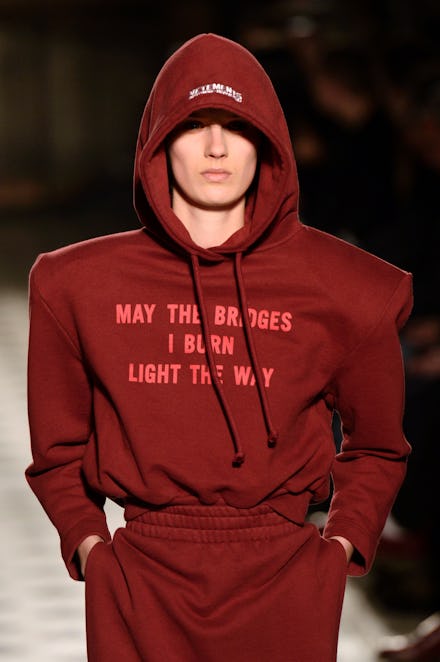The Complicated Racial History of the Hoodie — Before It Became a $1,000 Luxury Item

If you've perused any fashion blog or magazine within the past six months, you may have come to the realization that the most fashionable thing you could buy right now is a hoodie. More specifically, it should be a plain, oversized hoodie, nothing all that remarkable, except that it was designed by the Parisian design collective Vetements.
Oh, and it costs about $1,000.
Thanks to Vetements, the hoodie is "back," with Vogue touting that "this latest poster child for sloppy insouciance has made a serious fashion-forward leap of a comeback."
"Things are looking hoods-up come autumn," said another Vogue article.
"We've only just predicted that sweatshirts are going to be one of 2016's biggest fashion trends," wrote W magazine in January.
But "comeback" can't be quite accurate, because hoodies have never been out. In fact, the hoodie has been "in" since it was invented; but its meaning and coolness has always fluctuated depending entirely on who's wearing it — and society's judgment of the wearer.
A people's history of the hoodie: People have been wearing hoods since Ancient Rome. But the hooded sweatshirt as we know it (aka the hoodie) was first crafted by the sports company Champion in the 1930s. It was originally meant for athletes and laborers to shield them from the elements.
Quickly, though, it became an item associated with youth: Once the athletes got into hoodies, Rolling Stone notes, teens in high school and college started wearing them, and the appeal shifted from pure practicality to something more personal, with high school athletes trading them with their girlfriends.
Read more: Why Are We Still Calling White Tank Tops "Wife-Beaters"?
That association continued through the 1960s and 1970s, along with another association: an outsider status. Over the next several decades, the garment was embraced by different demographics simultaneously. As rappers adopted hoodies, athletes — as well as "street-toughs," embodied by as Sylvester Stallone in Rocky in 1976 — did too. In the 1970s, 1980s and into the 1990s, hoodies were worn by breakdancers and rappers and skaters and graffiti artists. Over the years, the link between hoodies and youth remained, as did a sort of renegade, rebellious status.
But whether that status was positive or negative has always depended on who was wearing the hoodie. It was regarded positively, for example, when it popped up in Silicon Valley as the uniform of tech wunderkinds like Mark Zuckerberg, who thumbed their noses at authority with their casual dress.
On the other hand, the hoodie has taken on a whole other meaning as worn by young men of color like Trayvon Martin, whose 2012 death revealed an entirely different interpretation of the hoodie.
Having been shot by a member of the neighborhood watch while wearing one with a bag of Skittles in the pocket, the 17-year-old's sweatshirt was seen as a threat, inherently linked to illicit activity — ostensibly because the person beneath the sweatshirt was young, male and black.
Bill O'Reilly, a pile of steaming garbage animate, directly blamed the garment for Martin's death, saying, "But he was wearing a hoodie and he looked a certain way. And that way is how 'gangstas' look."
In response, wearing hoodies at demonstrations, rallies and vigils became a political act. Entire basketball teams wore them, as did state senators, in a sign of solidarity as a movement for racial justice was born.
Fashion embraces the hoodie: But now, thanks to fashion, hoodies are "back" — and by back, we mean embraced by the fashion establishment as a trendy garment for privileged people. Because really, when you think about it, wearing a hoodie and feeling safe is a privilege for many, which leads us back to Vetements.
It's not like other designers haven't made high-end hoodies before. Take Kanye West, for example. For his Yeezy 3 extravaganza in February, many of the models did wear hoodies, which West then put on the market for more than $500. Before him, designers like Alexander Wang and Rick Owens and Dolce & Gabbana did the same.
But they aren't being credited for making the hoodie fashionable. That honor goes to Vetements, the untouchable Parisian design collective that's seduced the fashion world with its high prices, mysterious creators and elusive items. The label is aspirational; it embodies privilege. It also happens to be very, very white.
Just look at the Vetements showcase in Paris in March, in which every single model was tall, thin and an unwavering shade of white:
The lack of diversity was noticeable given how attuned fashion followers are these days to racial inclusion; it was also noticeable given the clothing styles Vetements was promoting.
Weeks after the show, Vogue actually wondered if the proliferation of hoodies on the runway was all thanks to Vetements. "Is Vetements inspiring Korean designers?" the site asked, observing that "the hoodie returned again and again, done up in different ways" at Seoul Fashion Week. Other sites published similar musings.
Meanwhile, West had presented a show full of hoodies weeks before — only in an ostentatious arena-sized event that showcased his decidedly unfashionable ego, on a bigger group of models, who all happened to be men and women of color.
The biggest criticism West gets as a fashion designer is that his collections are just a bunch of hoodies, leggings and sweatpants. Vetements' are, too. But whereas West is brash, uncouth and all-too-attainable in his prices and diversity, Vetements embodies every traditionally elite fashion virtue: exclusive, unattainable and wholly not diverse.
In those privileged hands, hoodies become luxury products worth $1,000. Presented by any other maker, worn by anyone else, well, they're something entirely different.